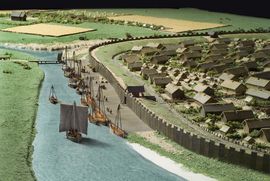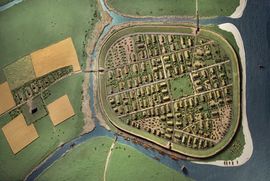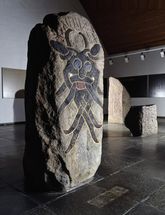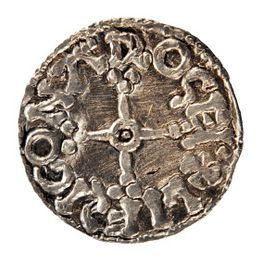Aarhus
Aarhus – or Aros as the town was called in the Viking Age – emerged around the 10th century. Its name means ”the mouth of the river”, and refers to the town’s location by the mouth of Aarhus Å (Aarhus River). Aarhus's position here on the river valley made it a key point in Jutland. Adam of Bremen mentions the town in the AD 1070s, and refers to it as a central seafaring town with connections to Funen, Zealand, Scania and Norway.
Aarhus river valley has provided optimal conditions for the growth of the city. The street of Immervad still exists in the present-day Aarhus, and its name refers to an old ford across the river. The ford created opportunities for natural traffic through the area as the river valley was difficult to traverse further inland.
Placement of the city
Ramparts were constructed around Aarhus as early as the 10th century. As far as possible, these were placed alongside natural watercourses which then functioned as moats. The ramparts were extended twice: Presumably at some time during the 11th the 12th centuries. In its final form the bank around the town was 20 m wide and around 4 m high.
It is estimated that the town inside the ramparts covered an area of around six hectares. It is difficult now to discern anything of the original the character and layout of the settlement because most house remains have long since decomposed or have been destroyed by later constructions. Traces of a plank-built road from the 11th century have been found on the inner side of the ramparts.
Aarhus' location, in the middle of Jutland's eastern coast and facing towards the Danish islands and the territories around the Kattegat, was strategically well chosen. For a commercial town this was, of course, an excellent location, but the town was presumably also an important base for the fleet. There is only sparse archaeological evidence of the town's maritime activities, but written sources contain descriptions of warfare in and around Aarhus. During the 12th century Aarhus was also Magnus' naval port in his battle against Eric Emune and the town was also the target of several attacks by the Wends. The additions to the town ramparts should probably be seen in the light of this.
A lot in Århus point towards a powerful founder. The construction of the town ramparts required many people and much material, and must have been initiated by order of the King.
The Church
Aarhus was not – like Ribe and Haithabu – a large, international commercial centre, but was primarily based on local trade. The town had its external commercial interests in the areas along the Kattegat and perhaps the Baltic Sea – as reported by Adam of Bremen in AD 1070. This conclusion is supported by the fact that finds from Western Europe are relatively few in Aarhus.
Written sources make several mentions of Aarhus in connection with ecclesiastical matters. The first is in AD 948 when the bishop of Aarhus participated in a great synod in Ingelheim in Germany together with the bishops of Ribe and Schleswig. It is, however, doubtful whether these men actually served as bishops in Denmark. Aarhus has evidence of early church building. A wooden church was possibly established west of the town wall – the site of Vor Frue Kirke (Our Lady's Church) today. This wooden church was presumably rebuilt several times. We know, for example, that Harold Hardrada burnt down the church during an attack on the town in AD 1050. Around 1060 AD – during the reign of Svein Edstridson – Aarhus again became an Episcopal residence. The bishop at that time was called Kristian and he participated in the Battle of England in 1069 AD. Clerics were also powerful outside the Church and as a rule the took part in the king’s campaigns.
Fact: At the end of the 11th century a great and magnificent cathedral – c. 45 m long and 12 m wide – was built from boulders and travertine in honour of the seafarers’ patron saint, St. Nicolai. The remains of the church’s walls are still standing as a part of the present Vor Frue Kirke, and the church's almost intact crypt was found in connection with an excavation in 1955 beneath the chancel of Vor Frue Kirke.
Runic Stones
No less than six runic stones have been found in Aarhus and environs, of which five are preserved. The texts on the stones are reminiscent of other runic texts: One or more persons are mentioned by name as being those who erected the stone, and it was erected in memory of a farther, brother or friend. Occasionally comments about the person’s character or about the cause of his death are also included. On one of the Aarhus stones, the front is decorated with a huge face mask showing a grimacing mouth, spiky beard and large, staring eyes. This motif is known from other finds. It may be a heathen symbol even though the stone is dated to the time around AD 1000. The stone must have been erected in honour of a rather important man, because the text ends with “he found death….when kings were fighting”.
Barbara Højlund & Frederik Schildt Nabe-Nielsen



